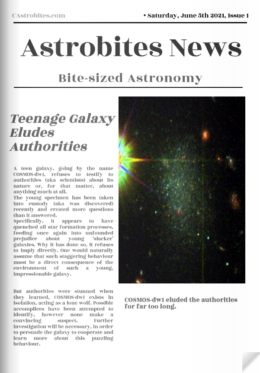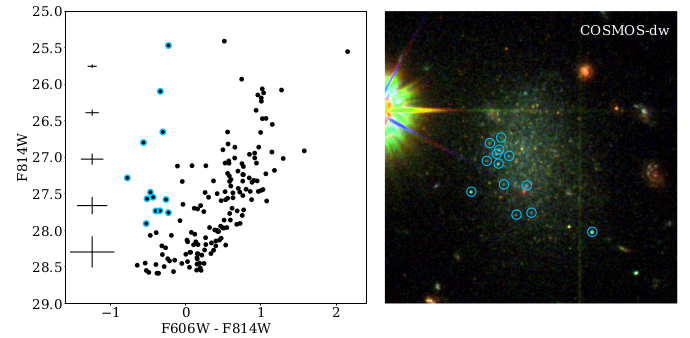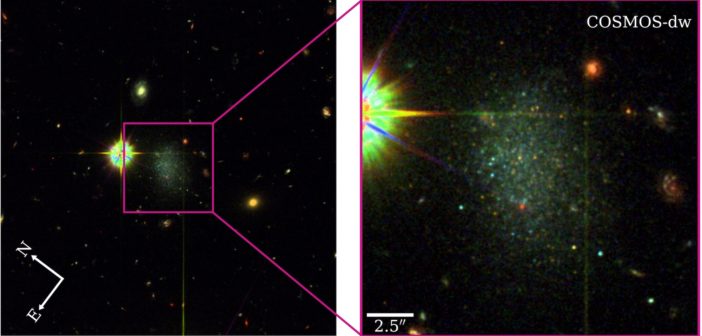Editor’s note: Astrobites is a graduate-student-run organization that digests astrophysical literature for undergraduate students. As part of the partnership between the AAS and astrobites, we occasionally repost astrobites content here at AAS Nova. We hope you enjoy this post from astrobites; the original can be viewed at astrobites.org.
Title: A recently quenched isolated dwarf galaxy outside of the Local Group environment
Authors: Ava Polzin, Pieter van Dokkum, Shany Danieli, Johnny P. Greco and Aaron J. Romanowsky
First Author’s Institution: Yale University
Status: Accepted to ApJL
Earth Orbit — Hubble
 A teen galaxy, going by the name COSMOS-dw1, refuses to testify to authorities (i.e., scientists) about its nature or, for that matter, about anything much at all.
A teen galaxy, going by the name COSMOS-dw1, refuses to testify to authorities (i.e., scientists) about its nature or, for that matter, about anything much at all.
The young specimen has been taken into custody (i.e., was discovered) recently and created more questions than it answered. Specifically, it appears to have quenched all star formation processes, feeding once again into unfounded prejudice about young “slacker” galaxies. Why it has done so, it refuses to imply directly. One would naturally assume that such staggering behavior must be a direct consequence of the environment of such a young, impressionable galaxy. But authorities were stunned when they learned that COSMOS-dw1 exists in isolation, acting as a lone wolf. An attempt to identify possible accomplices is underway, however none make convincing suspects thus far. Further investigation will be necessary to persuade the galaxy to cooperate and for us to learn more about this puzzling behavior.
An Addition to the Collection
Alright, this fictional newspaper snippet may simplify things a little. But it does provide a nice overview on the newly discovered young dwarf galaxy COSMOS-dw1, a (most likely) quenched galaxy outside of the Local Group, found by a stroke of luck. A galaxy is considered quenched if it has shut down all star formation. These small galaxies are fairly underrepresented in contemporary surveys, due to the bias of larger galaxies with high surface brightnesses being much easier to find.
In the context of galaxies, “small” or “low mass” refers to galaxies with masses below 107 solar masses (the Milky Way has roughly 1012 solar masses). The galaxy discussed in today’s paper is named COSMOS-dw1 and was discovered in archival Hubble Space Telescope data in the so-called COSMOS-CANDLES field, one of the most observed regions of the sky. It showed up as a semi-resolved object within the data, which suggests that it cannot be too far away.
But COSMOS-dw1 is not only interesting because it adds to our short list of well-documented low-mass galaxies, but also due to a number of further notable features: it displays a rather asymmetric shape with a clump of blue stars (which are hotter, heavier, and much more short-lived than yellow or red stars) off-center to the north (see Figure 1). The rest of the stellar population appears to be much older — most likely post-main sequence — and is distributed more evenly.

Figure 1: Color–magnitude diagram of COSMOS-dw1 (left). The blue points refer to the bright blue stars marked in the RGB image of the galaxy (right). [Adapted from Polzin et al. 2021]
Missing Lines
In order to learn more about the galaxy, spectroscopic observations were taken by the authors with the Low Resolution Imaging Spectrograph (LRIS) on the Keck I telescope in Hawaii. A distance of around 22 Mpc was deduced from the measurements, and the galaxy’s radius was determined to be around 450 pc (around 127 times smaller than the Milky Way), with a mass of 2.4 x 106 solar masses.
Arguably the most important information obtained from the spectroscopy measurements is the absence of emission lines, specifically H-alpha emission lines. In galaxy research, the brightness of the H-alpha line indicates the number of massive stars within that galaxy, which can be used to infer the rate of star formation. Massive stars ionize the gas around them. The hydrogen recombination produces line emission, such as the well-known Balmer-series lines of H-alpha and H-beta. The lack of H alpha emission suggests that the galaxy is in fact quenched, i.e., it does not produce any new stars at the moment. However, strong Balmer absorption is visible, implying the presence of A-type stars at an age of roughly 1 Gyr. Figure 2 displays the spectrum of COSMOS-dw1 and the location of where H-alpha emission would be expected, as a function of wavelength.

Figure 2: LRIS spectrum of COSMOS-dw1 in black with the best-fit model overplotted in pink. The gray area on the right shows the wavelength range where H-alpha emission would be expected. [Adapted from Polzin et al. 2021]
A Lone Wolf
So, why has this young galaxy ceased all star formation, at least for the moment? The authors point out that usually dwarf galaxies are quenched due to environmental effects, such as ram pressure — the process of pressure from the environment stripping a small galaxy of the gas essential for star formation as the galaxy falls towards a larger mass.
For any kind of environmentally caused quenching, one would expect to see a bright companion galaxy close to the dwarf galaxy. Intriguingly, such a companion is nowhere to be found for COSMOS-dw1. The authors have searched the immediate surroundings of the dwarf galaxy and found only two galaxies that exceed the minimum mass to be considered a “luminous neighbor”. However, it appears these are too far away to be responsible for the quenching. Additionally, the complex stellar population within COSMOS-dw1 suggests that star formation started and stopped several times in the past. We also know that the quenching happened rather recently due to the population of rather young stars.
Supernovae to the Rescue!
The authors propose a different mechanism responsible for quenching: internal feedback from supernovae. This basically means that a violent process such as a supernova may inject energy and momentum into the interstellar medium — enough maybe to shut off star formation, at least temporarily. The clump of blue stars found within COSMOS-dw1 may be the location of this feedback event.
More surveys may help us to better understand these dwarf galaxies. The authors note that finding this quenched small galaxy in such a well-studied field in the sky suggests that they are fairly common.
While we are quite calmly and comfortably existing in a side arm of a spiral galaxy that does not currently experience any violence, it is exceedingly interesting to take a look at other galaxies, especially outside the Local Group, to gain a perspective on the many altering processes happening to other galaxies and the star formation within. Space is always dynamic; even if an object such as COSMOS-dw1 exists in isolation, rapid exchange of energy and great change can always come from within.
Original astrobite edited by Alex Pizzuto.
About the author, Jana Steuer:
I’m a second year PhD student at the LMU Munich, working for the University Observatory (USM), which owns the 2.1m Fraunhofer Telescope Wendelstein. My field of research is exoplanets. I hunt for traces of them in data from big surveys, like the TESS mission and then follow them up, using spectroscopy and photometry. Mainly, I focus on long period planets that may potentially harbor life. When I’m not planet hunting, I act as a DM for several Dungeons and Dragons groups and annoy people with facts from Tolkien’s Silmarillion. I enjoy kickboxing and learning about ancient human history.
